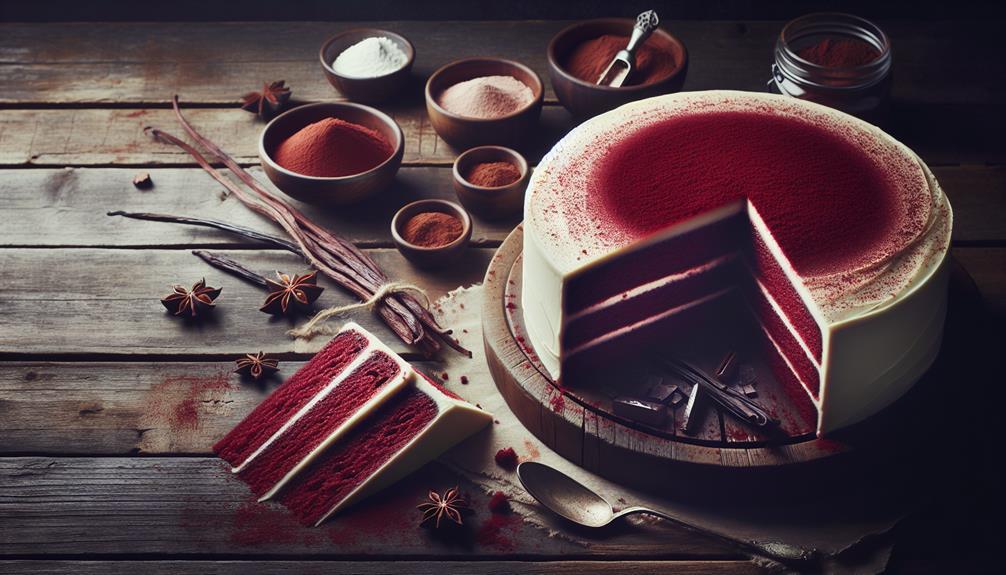Have you ever wondered why some Red Velvet cakes aren't actually red? It's a bit of a culinary puzzle! The color of Red Velvet cake can vary dramatically, and it mostly comes down to the type and amount of coloring used—whether it's natural options like beet juice or a splash of artificial dye. Plus, the chemical reactions between the ingredients, particularly the cocoa and the acidity, can either amplify or mute the redness. What's even more intriguing is how these elements can interact differently under various baking conditions. So, let's peel back the layers to uncover what really gives Red Velvet its signature hue—or why sometimes, it doesn't.
Table of Contents
Key Takeaways
- Natural cocoa used in the recipe reacts with baking soda, darkening the cake to a brownish hue.
- High baking temperatures can degrade red colorants, leading to a browner appearance.
- The type and amount of food dye used can affect the intensity and shade of red.
- Variations in regional recipes may use less vibrant or different types of coloring agents.
- Changes in pH levels from ingredients like vinegar can alter the final color outcome of the cake.
The History of Red Velvet
The story of red velvet cake began during the Great Depression when bakers used beet juice to enhance the color of their cakes. Originally, the natural acidity of the beets reacted with the ingredients to give the cake a mild chocolate flavor and a reddish hue, making it stand out among other desserts. This was a clever move at a time when ingredients were scarce and expensive, and it marked the beginning of what I'd call the 'velvet evolution.'
As the years passed, red velvet cake evolved from a thrifty option to a beloved classic in American baking. It became a symbol of original desserts, showcasing ingenuity in baking techniques and ingredient use. The name itself, 'velvet,' implies a smooth, soft texture which the cake traditionally has, thanks to the careful mixing of ingredients to maintain a fine, dense crumb.
Through its history, red velvet cake has been more than just a treat—it's a reflection of the creativity of bakers who adapted their recipes according to the resources available. This adaptability is what kept the cake popular through decades, evolving with trends and tastes while maintaining its signature appeal.
Cocoa Powder Chemistry
Cocoa powder's role in red velvet cake isn't just about flavor; it plays a vital role in achieving that classic color. You see, the type of cocoa powder you use can greatly impact the cake's appearance and taste. Let's delve into the chemistry behind this.
The cocoa powder used in traditional red velvet cake is natural, unalkalized cocoa. This type of cocoa is acidic and reacts with the baking soda in the recipe, which is alkaline. This reaction not only helps the cake rise but also enhances the reddish-brown hue of the cocoa. Now, if you switch to Dutch-processed cocoa, which has been treated with an alkali to neutralize its acids, you'll find it doesn't react the same way. This results in a cake that's more brown than red.
Cocoa sourcing is important here. Different regions produce cocoa beans with varying flavor profiles and acidity levels. For instance, beans from Africa might be more acidic than those from South America, affecting both the flavor and color outcome of your cake. It's fascinating how these subtle differences in cocoa chemistry can alter the entire character of a classic dessert like red velvet cake.
The Role of Food Dyes
Despite its historical roots, today's red velvet cakes often rely on food dyes to achieve their vibrant color. This shift from natural coloration to the use of artificial dyes mainly stems from a desire to maintain color stability under varied conditions. Let's explore why this is significant.
Color stability is important in baking because it guarantees the product remains visually appealing from oven to table, and even on store shelves. Natural ingredients can change hue depending on factors like pH levels and heat, making them unreliable for consistent coloring. On the other hand, synthetic dyes provide a reliable vibrancy that doesn't fade or alter under typical baking conditions.
Additionally, dye regulations play an essential role in how these colors are used in food products. Regulatory bodies, such as the FDA in the United States, set strict guidelines on which dyes can be used in foods and in what amounts. These regulations ensure that the dyes are safe for consumption and that their use leads to the expected outcomes without misleading the consumer.
Natural Vs. Artificial Coloring
Often, we see a clear divide between natural and artificial coloring in baking, each with its own set of advantages and drawbacks. Natural dyes, derived from fruits, vegetables, and spices, appeal to those of us concerned about synthetic additives. They're perceived as safer and more wholesome. However, they can be less vibrant in color perception compared to their artificial counterparts. For instance, beetroot gives a lovely hue, but it's more muted than what you'd get from a bottle of red food coloring.
Artificial colors, on the other hand, are engineered for eye-popping results, ensuring that red velvet cake looks strikingly red. They're consistent, potent, and don't alter the flavor of your treats. Yet, they come with their own baggage. Many folks worry about synthetic chemicals in their food, and some artificial colors have been linked to allergy concerns and other health issues. It's important to take into account these factors when selecting your coloring agent.
Impact of Baking Temperature
So, let's talk about how baking temperature can really mess with the color of your red velvet cake.
If you don't get the temperature just right, you might end up with something that's more brown than red.
High heat tends to zap the brightness right out, so finding that sweet spot is key to keeping things vibrant.
Temperature Affects Color Change
Baking temperature plays a vital role in determining the final color of red velvet cake. When I bake, I've noticed that if the oven's too hot, the cake loses its vibrant red hue, turning more brownish. This happens because high heat can break down the red food coloring.
What's essential here is maintaining heat consistency throughout the baking process to guarantee color stability. If the oven temperature fluctuates, it doesn't just risk an uneven bake; it also messes with the color. By keeping a steady temperature, I can better preserve that classic red velvet look.
It's all about finding that sweet spot where the heat is just right to keep the color bright and inviting.
Optimal Baking Heat Range
Understanding the best heat range for baking red velvet cake helps guarantee that the color remains vivid and appealing. Oven calibration is vital here; it ensures the temperature is just right, optimizing both the cake's texture and the stability of its ingredients. Typically, baking at around 350 degrees Fahrenheit works best. This moderate temperature allows the cake to cook evenly without compromising the integrity of delicate components like cocoa, which plays a big part in the cake's iconic color.
Ensuring the oven doesn't swing too hot or too cold is essential. It's not just about following a recipe; it's about mastering the environment your cake bakes in. This precision leads to perfect outcomes every time.
High Heat Impact
When you bake red velvet cake at high temperatures, it can drastically alter its color and texture. High heat leads to what's known as heat degradation. This isn't just about a burnt top; it's about how the very nature of the colorants in the cake reacts.
Most red velvet cakes get their color from a mix of natural cocoa and food coloring. Both of these are susceptible to changes under high heat. Their thermal stability is low, meaning they break down and lose their vibrant hues when exposed to intense temperatures.
Variations in Recipe Ingredients
Various ingredients can greatly alter the traditional hue of red velvet cake. Depending on ingredient availability and the desired flavor profiles, bakers often tweak the standard recipe, leading to variations in color.
For instance, the type of cocoa used is important. Natural cocoa powder, which is acidic, reacts with the baking soda, typically enhancing the red color. On the other hand, Dutch-processed cocoa has been alkalized, so it's darker and doesn't contribute much to the red coloring.
Different sweeteners can also affect the color. Granulated sugar is the norm, but using brown sugar or molasses might darken the cake, moving it away from the iconic red to a more maroon shade. Even the type of fat used plays a role. While most recipes call for oil, substituting it with butter for a richer flavor can subtly influence the shade of red.
Moreover, the choice of red dye—whether it's a natural beet extract or a synthetic food coloring—can vary the intensity and tone of the red. Some bakers prefer a vibrant, eye-catching red that only certain artificial dyes can achieve, while others might opt for a more natural hue with vegetable-based colors. Each choice directly impacts the visual and taste appeal of the final product.
How Acidity Affects Color
So, let's talk about how acidity changes the color of our beloved red velvet.
The pH levels really play a big part, altering the chemical reactions that determine the cake's color.
Decoding these reactions helps us understand why sometimes red velvet isn't as red as we expect.
Ph Levels Influence
Understanding how pH levels influence color reveals why red velvet sometimes isn't red at all. It's all about the chemistry between ingredients, specifically the purity and their reactions to pH changes. For instance, the natural cocoa used in traditional recipes is rich in anthocyanins, which are sensitive to pH levels. These compounds react distinctly depending on the acidity or alkalinity present.
Vinegar, a common ingredient in red velvet, plays an important role here. It's meant to lower the pH and maintain the red hue from the anthocyanins. However, if the vinegar isn't pure or is insufficiently acidic, or if other ingredients alter the pH balance, the expected vibrant red can shift towards brown. Therefore, the purity and balance of these ingredients are essential.
Chemical Reactions Decoded
Let's now explore how acidity directly impacts the color changes in red velvet's chemistry. The secret lies in the ingredient interactions, particularly between the cocoa powder and the acidic components like vinegar or buttermilk. Cocoa contains anthocyanins, natural pigments that are sensitive to pH levels. In more alkaline environments, these pigments turn reddish. However, the typical importance in red velvet recipes can mute this natural red, leading to a browner hue unless adjusted.
To guarantee color stability in your red velvet, managing the acidity is essential. By tweaking the amounts of acidic ingredients, you can manipulate the pH level to enhance or subdue the redness. It's all about finding that perfect balance to achieve the vibrant color we all love.
The Illusion of Color Intensity
Red velvet's iconic color often tricks our eyes into seeing a richer hue than what's actually present. This phenomenon is rooted deeply in how we perceive color and the visual contrasts that influence our perception. It's not just about the actual pigments used; it's how those colors play with our minds.
Here's what really contributes to this illusion:
- Lighting Conditions: The brightness and type of light can dramatically affect how we see red velvet's color. In dim light, it might appear darker and richer than it actually is.
- Surrounding Colors: What's next to our red velvet? If it's placed near darker colors, it seems brighter and more vivid due to contrast.
- Ingredient Proportions: The specific mix of cocoa and dye affects the depth of color. More cocoa generally leads to a darker, more subdued tone.
Understanding these elements helps me appreciate the art and science behind red velvet's allure. It's not just a cake; it's a masterpiece of color perception and visual contrast. Each slice not only appeals to my taste buds but also plays a clever game with my eyes, showcasing the fascinating interplay of ingredients and optics.
Regional Recipe Differences
So, let's talk about how red velvet cakes can differ from place to place. Ingredients can change based on what's available locally, which definitely influences the final color and taste of the cake.
Also, what people prefer regarding flavor can vary a lot between different regions.
Ingredients Vary Locally
Depending on where you are, the ingredients used in red velvet recipes can vary greatly. This is primarily due to ingredient availability and the need for flavor adaptation in different regions. Here's how:
- Buttermilk: In some places, buttermilk is a staple, while in others, yogurt or sour cream might be used to achieve a similar tanginess.
- Cocoa Type: Depending on regional preferences, the type of cocoa can change from natural unsweetened to Dutch-processed, impacting the cake's color and flavor.
- Coloring Agents: While some areas might stick with traditional food colorings, others might opt for beetroot juice or none at all, depending on local tastes and the availability of ingredients.
These variations ensure that red velvet maintains its beloved status globally, albeit with a local twist.
Cultural Taste Preferences
Building on how ingredients vary, it's fascinating to see how cultural taste preferences shape regional red velvet recipes. Depending on where you are, you'll notice the flavor evolution in this iconic cake isn't just about color—it's deeply entrenched in how locals adapt ingredients to suit their palates.
In some places, beetroot boosts the traditional red hue and adds earthiness, aligning with a preference for natural ingredients. Elsewhere, extra cocoa is added, catering to those who can't get enough of that rich, chocolaty depth. These ingredient adaptations aren't random; they're a reflection of what locals love and expect in their desserts. It's a vivid example of how regional tastes direct the course of culinary evolution.
Consumer Expectations and Reality
Expecting a vibrant red, many consumers are surprised when they slice into a red velvet cake and find a color that's more subdued. It's a common disconnect between what we see in ads and what we actually get, and it's all rooted in marketing strategies that play with our sensory perception. The mismatch can leave some of us feeling a bit cheated, wondering why the reality doesn't meet our expectations.
Here's why this happens:
- Color Variation: The intensity of red in red velvet cake can vary widely depending on the type and amount of food coloring used. Some bakers opt for more natural hues, reducing the brightness seen in commercials.
- Photographic Enhancement: Images used in marketing often enhance the colors to make them pop on your screen or in print. This isn't just true for food but for clothing, gadgets, and virtually any consumer good.
- Cultural Representation: Depending on where you're in the world, the shade of red might be adjusted to align with local tastes and preferences, which aren't always the fiery red advertised.
Understanding these factors helps bridge the gap between my expectations and the reality, enhancing my appreciation for what truly goes into creating that perfect slice of cake.
Frequently Asked Questions
Can Red Velvet Flavor Allergies Be Triggered by Specific Ingredients?
Yes, specific ingredients in red velvet can trigger allergies. It's important to identify what you're sensitive to, whether it's the cocoa, food coloring, or other additives. Always check for your particular allergens!
What Is the Origin of the Name "Red Velvet"?
The name "red velvet" reflects its color history and recipe evolution. Originally, the cake's natural cocoa reacted with acids, creating a reddish hue that's been enhanced by food coloring in modern recipes.
Are There Any Unique Nutritional Benefits to Red Velvet?
I've checked the ingredient analysis and health comparisons, but there aren't any unique nutritional benefits to red velvet. It's similar to other cakes, just with added color and a hint of cocoa.
How Does Red Velvet Taste Differ From Chocolate?
Red velvet's taste is milder than chocolate due to lower cocoa intensity. Buttermilk's role gives it a tangy flavor that distinguishes it from richer, straightforward chocolate desserts. They're subtly different but equally delicious.
What Are the Most Popular Red Velvet Desserts Worldwide?
I've noticed that the most popular red velvet desserts vary globally due to cultural variations and ingredient adaptations. You'll find everything from classic cakes to cupcakes and even ice creams topping the list!
- Chemistry's Role in Fabric Production - July 25, 2024
- Moisture Management in Modern Fabrics - July 25, 2024
- Engineering Fabrics for Optimal Performance - July 25, 2024






